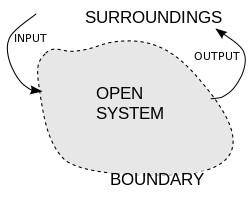Theory of national and international politics.
The actions of parties, pressure groups and states, and the relations between them, are fruitfully studied by looking at ‘inputs’ and ‘outputs’ or pressures and actions on the one hand, and the resultant policies on the other.
The internal responses and calculations – or the ideological or pragmatic considerations of the institutions involved – are treated as irrelevant or invisible; as if they took place within a ‘black box’, and did not need to be considered when examining what goes into the box, or what comes out of it.
Akin to billiard ball model
Also see: axiomatic theory, systems theory
Source:
Alan Bullock, Oliver Stallybrass, and Stephen Trombley, eds, The Fontana Dictionary of Modern Thought, 2nd edn (London, 1988)
History

A black box model can be used to describe the outputs of systems
The modern meaning of the term “black box” seems to have entered the English language around 1945. In electronic circuit theory the process of network synthesis from transfer functions, which led to electronic circuits being regarded as “black boxes” characterized by their response to signals applied to their ports, can be traced to Wilhelm Cauer who published his ideas in their most developed form in 1941.[2] Although Cauer did not himself use the term, others who followed him certainly did describe the method as black-box analysis.[3] Vitold Belevitch[4] puts the concept of black-boxes even earlier, attributing the explicit use of two-port networks as black boxes to Franz Breisig in 1921 and argues that 2-terminal components were implicitly treated as black-boxes before that.
In cybernetics, a full treatment was given by Ross Ashby in 1956.[5] A black box was described by Norbert Wiener in 1961 as an unknown system that was to be identified using the techniques of system identification.[6] He saw the first step in self-organization as being to be able to copy the output behavior of a black box. Many other engineers, scientists and epistemologists, such as Mario Bunge,[7] used and perfected the black box theory in the 1960s.
System theory

The open system theory is the foundation of black box theory. Both have focus on input and output flows, representing exchanges with the surroundings.
In systems theory, the black box is an abstraction representing a class of concrete open system which can be viewed solely in terms of its stimuli inputs and output reactions:
The constitution and structure of the box are altogether irrelevant to the approach under consideration, which is purely external or phenomenological. In other words, only the behavior of the system will be accounted for.
— Mario Bunge[7]
The understanding of a black box is based on the “explanatory principle”, the hypothesis of a causal relation between the input and the output. This principle states that input and output are distinct, that the system has observable (and relatable) inputs and outputs and that the system is black to the observer (non-openable).[8]
Recording of observed states
An observer makes observations over time. All observations of inputs and outputs of a black box can be written in a table, in which, at each of a sequence of times, the states of the box’s various parts, input and output, are recorded. Thus, using an example from Ashby, examining a box that has fallen from a flying saucer might lead to this protocol:[5]
| Time | States of input and output |
|---|---|
| 11:18 | I did nothing—the Box emitted a steady hum at 240 Hz. |
| 11:19 | I pushed over the switch marked K: the note rose to 480 Hz and remained steady. |
| 11:20 | I accidentally pushed the button marked “!”—the Box increased in temperature by 20 °C. |
| 11:21 | Etc. |
Thus every system, fundamentally, is investigated by the collection of a long protocol, drawn out in time, showing the sequence of input and output states. From this there follows the fundamental deduction that all knowledge obtainable from a Black Box (of given input and output) is such as can be obtained by re-coding the protocol (the observation table); all that, and nothing more.[5]
If the observer also controls input, the investigation turns into an experiment (illustration), and hypotheses about cause and effect can be tested directly.
When the experimenter is also motivated to control the box, there is an active feedback in the box/observer relation, promoting what in control theory is called a feed forward architecture.

This really answered my problem, thanks!
Very good info. Lucky me I came across your site by accident (stumbleupon). I have saved as a favorite for later.
Greetings! Very useful advice within this article! It’s the little changes that make the largest changes. Many thanks for sharing!